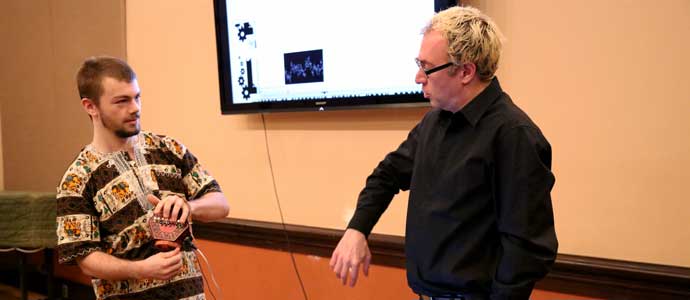The Sonic Banana is a two-foot long orange tube equipped with motion sensors. With each dreamlike bend of the tube, a series of solemn arpeggios emerges: the sound of an entire choir emitting from one ordinary piece of rubber. Its creator, Eric Singer, plays the Sonic Banana with the intensity of a virtuoso (“You have to adopt a very serious expression when you’re playing an instrument like a rubber tube,” he said). He designed the instrument as an alternative MIDI controller, the player’s gestures communicating to the computer to control the types of sounds materialized.
The Sonic Banana, both playful and ingenious, is emblematic of Singer’s work. Singer is the founder of LEMUR, the “League of Electronic Musical Urban Robots,” a collective of artists and technologists who create robotic musical instruments. A self-described “engineer of very strange things,” Singers works as a musician, artist, and computer scientist to create interactive installations from unusual materials. Created with a DIY ethos, his instruments are playful, interactive, and intuitive. His philosophy: “How do I take things that aren’t musical instruments and turn them into musical instruments?”
With new software, Singer said, a sound can be detached from the container from which it emerges. The physics of the instrument no longer determines how the instrument might be played or what kind of sound might emerge. “You blow a sax, and a symphony comes out,” Singer said, “there are no limits.” This represents new opportunities for re-imagining the relationship between aurality and artifact.
As Evan Ziporyn, MIT Kenan Sahin Distinguished Professor of Music, notes, “The art and artifice are in […] figuring out what the personality of a sonic banana might be, what its movements as movements might evoke, even if they physically wouldn’t produce them anyway. Because if you can make them sound like anything, you could also make them sound like things that don’t fit with their ‘personality’ — the art is in imagining what that personality would be sonically; the artifice is having the chops (coding and engineering skills) to produce it.”
The popular perception of robots is that of the cold automaton, but Singer’s creations demonstrate a more seamless integration of human and machine. His robots are expressive. They interact. Far from being predictable or orderly, they introduce an element of chaos to the composition. And, as Singer says, “they are more interesting to look at than a synth.” Robots, it appears, have stage presence. With them, Singer demonstrates how mechanical objects can be intimately enmeshed with those qualities we associate with the natural: the body, the affective, the handmade, and the acoustic.
Singer’s musical projects feature a variety of collaborations between robots and human performers. Renowned musicians and composers such as Pat Metheny, They Might Be Giants, Jim Thirlwell, Morton Subotnick, George Lewis, Ikue Mori, Todd Reynolds, and Ben Neill have performed with the robots, which often take on a life force of their own. The success of these collaborations is perhaps because Singer pays equal attention to the humans using the machines as the machines themselves. “I observe people using [the instruments] and then I reprogram them accordingly,” he said.
Singer and MIT student Otto discuss his invented instruments. Credit: Tracy Strain.
Singer’s interactive instrument, the LEMUR-Tron. Credit: Evan Cairo

